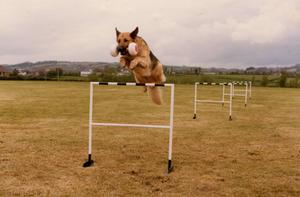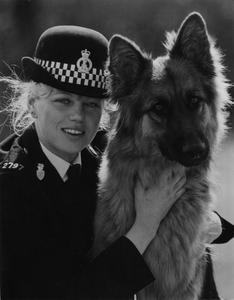The real Paw Patrol: a short history of police dogs
Throughout mankind’s long and storied relationship with dogs, we’ve employed our pooch pals in a number of supporting roles, ranging from shepherds to guard dogs and stage-trained performers. But perhaps the most iconic partnership between man and his best friend is the noble police dog (or K9 unit), a heavily trained and highly-disciplined pup, often accompanied by a unique handler.
Although modern police dogs came into common use around the turn of the Twentieth Century, dogs have been used to enforce local laws since the Middle Ages, with bloodhounds especially used for tracking criminals using their keen sense of smell. An attempt was even made to track the infamous serial killer Jack the Ripper using a gang of bloodhounds; unfortunately, due to poor training, they only succeeded in biting the commissioner’s hand and scarpering! [1]

Bloodhounds with their handlers on a grassy moor. Image reference PA/1/17/1/1
Some of the most common breeds used in policing include the German Shepherd, the Labrador and the Doberman, although their roles and responsibilities vary depending on attributes. Because of the importance of their work to modern policing, canine candidates must be assessed rigorously, necessitating the hosting of local dog trials where they can be assessed on certain criteria, such as temperament, tracking skills and physical fitness.

A German Shepherd jumping hurdles at a police dog trial. Image reference PA/3/9/1/4

Astor and Feral, the Devon and Cornwall Police’s first serving police dogs. Image reference PA/1/17/1/1
Dog units quickly became prevalent in European countries such as France and Germany in the early 20th Century, and the effectiveness of their work led to the UK quickly following suit, with the North-Eastern Railway Police amongst the first to employ them. In the Devon and Cornwall Constabulary alone, police dogs are credited with responding to over 6000 alerts a year and making around 900 arrests.[2]
As a result, many of the force’s serving hounds have become local celebrities in their own right. Devon and Cornwall’s famous pups include Blade – whose handler, Natalie Cole, was the first female dog handler in the constabulary – Astor & Feral, who were the constabulary’s first serving police dogs, and Kain, who was tragically killed when confronting a gun-wielding criminal during a standoff. Outstanding service from police dogs is recognized by the Thin Blue Paw Foundation (who financially support retiring dogs), and handler-dog duos generally receive equal commendation for their service.

PC Natalie Cole with her PD, the German Shepherd, Blade. Image reference PA/3/9/1/1
The role and responsibilities of police dogs have changed throughout the seventy years they have been employed. Initially, one of the most common jobs they were given was tracking criminals and fugitives across large urban and country areas using their keen sense of smell. In one notable case, a police dog named Koenig was able to track a Dartmoor escapee to the bottom of a sixty feet-deep ravine.[3]
They were also trained in incapacitating criminals, with handlers directing them to bite down on a perpetrator’s arm in order to prevent them from using a weapon and to secure them until an arrest could be made. Nowadays, police dogs are used primarily to hunt for drugs, weapons, explosives, and technology, but although they are often kept on leashes as a form of deterrence in certain cases they are still allowed to pursue and take down criminals.
The average working life of a police dog is between 6-9 years, with certain constabularies offering a pension to cover the dog’s medical bills for the remainder of its life. Many police dogs will retire to live with their handler, and although old age and/or medical conditions are the most common cause of retirement, dogs can also be retired if they have become pregnant, in order to raise their puppies.[4]
Police dogs play a huge part in the function of the modern police force, at a local, national and international level. Whilst the technology used as part of police investigation might grow increasingly more advanced year-upon-year, the ever-sharp senses of our four-legged friends can always be relied upon for some old-school sleuthing.
You can read more about historic police dogs here: https://www.k9memorialuk.co.uk/
To support the recognition of police dog’s work and retirement costs, visit the Thin Blue Paw Foundation here: https://www.thinbluepaw.org.uk/
Pawsome Pensions, a local charity based across Devon, Dorset and Cornwall, also supports retired police dogs and fire dogs. To support Pawsome Pensions, visit: https://www.pawsomepensions.org.uk/
References
- ^ ‘LONDON’S DISGRACE: SIR CHARLES WARREN AND HIS PACK OF HOUNDS’, Atchison Daily Globe (17 October 1888), Available at: https://www.casebook.org/press_reports/atchison_daily_globe/881017.html?printer=true
- ^ ‘The Role of the Police Dog in Devon and Cornwall’, PA/1/17/1/1
- ^ ‘Dogs are helping West police in their work’ (7th September 1956), PA/1/17/1/1
- ^ ‘Proactive Deterrence’, page 12, K-9 Cop Magazine (April/May 2010), Available at: https://web.archive.org/web/20130531002846/http://www.bpdnews.com/wordpress/wp-content/uploads/K9COPMag_BostonPD.pdf


Post your own comment